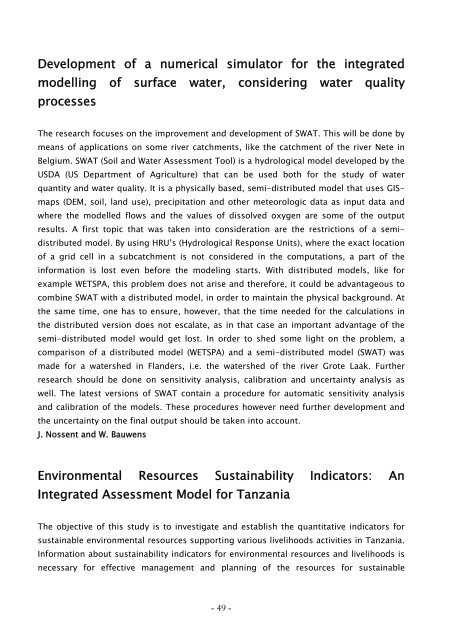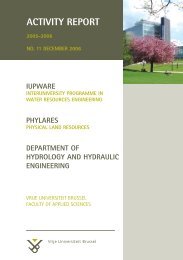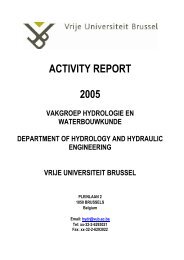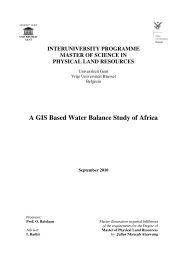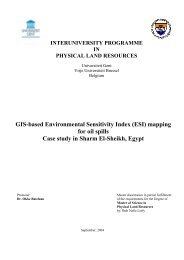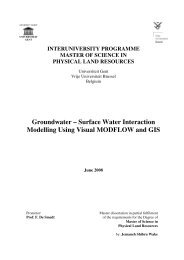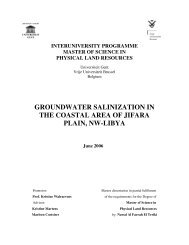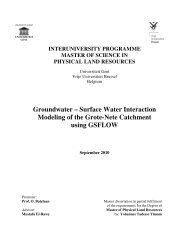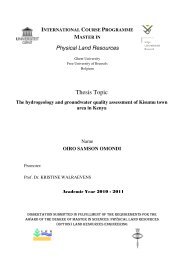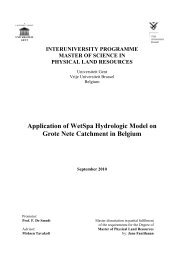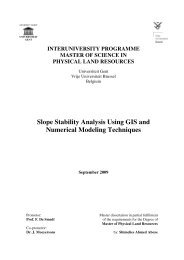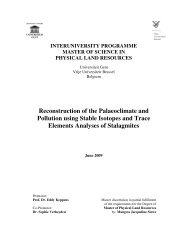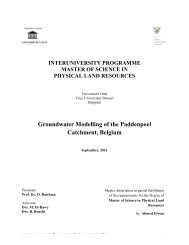C O N T E N T S - Physical Land Resources - Vrije Universiteit Brussel
C O N T E N T S - Physical Land Resources - Vrije Universiteit Brussel
C O N T E N T S - Physical Land Resources - Vrije Universiteit Brussel
Create successful ePaper yourself
Turn your PDF publications into a flip-book with our unique Google optimized e-Paper software.
Development of a numerical simulator for the integratedmodelling of surface water, considering water qualityprocessesThe research focuses on the improvement and development of SWAT. This will be done bymeans of applications on some river catchments, like the catchment of the river Nete inBelgium. SWAT (Soil and Water Assessment Tool) is a hydrological model developed by theUSDA (US Department of Agriculture) that can be used both for the study of waterquantity and water quality. It is a physically based, semi-distributed model that uses GISmaps(DEM, soil, land use), precipitation and other meteorologic data as input data andwhere the modelled flows and the values of dissolved oxygen are some of the outputresults. A first topic that was taken into consideration are the restrictions of a semidistributedmodel. By using HRU’s (Hydrological Response Units), where the exact locationof a grid cell in a subcatchment is not considered in the computations, a part of theinformation is lost even before the modeling starts. With distributed models, like forexample WETSPA, this problem does not arise and therefore, it could be advantageous tocombine SWAT with a distributed model, in order to maintain the physical background. Atthe same time, one has to ensure, however, that the time needed for the calculations inthe distributed version does not escalate, as in that case an important advantage of thesemi-distributed model would get lost. In order to shed some light on the problem, acomparison of a distributed model (WETSPA) and a semi-distributed model (SWAT) wasmade for a watershed in Flanders, i.e. the watershed of the river Grote Laak. Furtherresearch should be done on sensitivity analysis, calibration and uncertainty analysis aswell. The latest versions of SWAT contain a procedure for automatic sensitivity analysisand calibration of the models. These procedures however need further development andthe uncertainty on the final output should be taken into account.J. Nossent and W. BauwensEnvironmental <strong>Resources</strong> Sustainability Indicators: AnIntegrated Assessment Model for TanzaniaThe objective of this study is to investigate and establish the quantitative indicators forsustainable environmental resources supporting various livelihoods activities in Tanzania.Information about sustainability indicators for environmental resources and livelihoods isnecessary for effective management and planning of the resources for sustainable- 49 -


